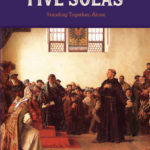My new book on the Five Solas is now available in Ebook and audiobook:
Category Archives: Five Solas
Sola Gratia – Grace Alone
I am thankful for today’s opportunity to share God’s word. I was able to say a whole lot on the vital theme of “Sola Gratia” (Grace Alone) in just under an hour.
The host, Julio Rodriguez wrote, “Today, I had the privilege of having John Samson join me on BRIDGE Radio to talk about the Reformation and “Sola Gratia”, that is ‘By Grace Alone.’ On today’s episode, we discuss why it is only by God’s grace that we are saved and not by our works or through other means. The Word of God describes the human condition as being completely unable to achieve salvation on his own. We review Pelagianism, Semi-Pelagianism, and both the Roman Catholic and Protestant Arminian view of God’s Grace in relation to our salvation. What is the correct view? Do I play any part in my salvation? Well, tune in to find out!”
Here’s a link to the podcast.
The paperback version of my new book “The Five Solas – Standing Together Alone” is available here.
The ebook and audio version is available here.
A Fresh Look At the Five Solas
 Over the last five Sundays in a sermon series at King’s Church, we have been taking a fresh look at the Five Solas of the Reformation. In that time, we have drunk deeply at the well of salvation and seen the Lord Jesus Christ and His power to save in new and fresh ways. It has been a joy! I hope the series can be a blessing to others also, and so make these sermons available here.
Over the last five Sundays in a sermon series at King’s Church, we have been taking a fresh look at the Five Solas of the Reformation. In that time, we have drunk deeply at the well of salvation and seen the Lord Jesus Christ and His power to save in new and fresh ways. It has been a joy! I hope the series can be a blessing to others also, and so make these sermons available here.
Sola Scriptura: Sermon: The More Sure Word
Sola Fide: Sermon: The Heart of the Gospel
Sola Gratia: Sermon: Every Christian is a Miracle
Solus Christus: Sermon: Federal Headship – Adam and Christ
Soli Deo Gloria: Sermon: The Meaning of Life
 The eBook and Audio Book Version of my new book is also now available at this link.
The eBook and Audio Book Version of my new book is also now available at this link.
God bless,
John
